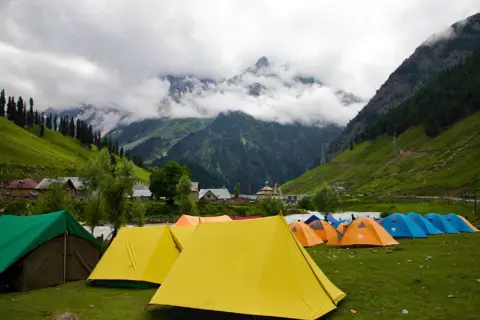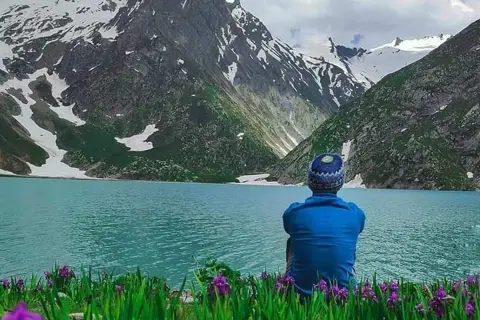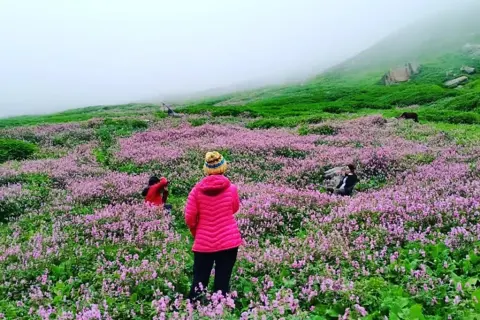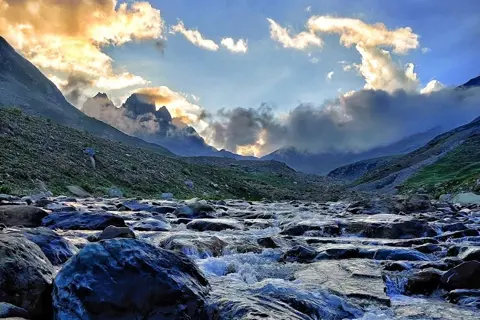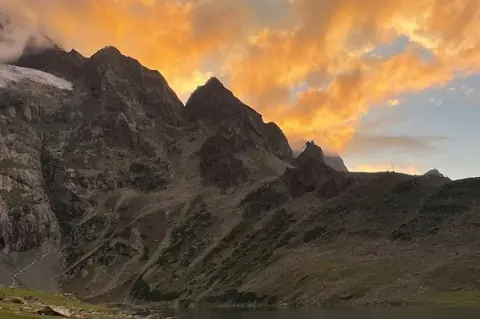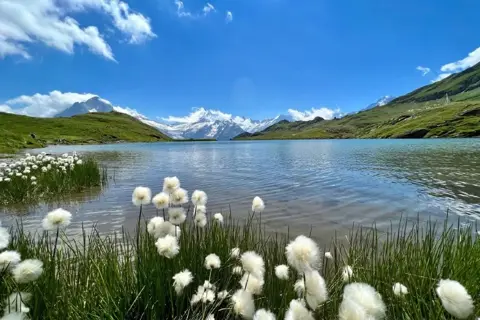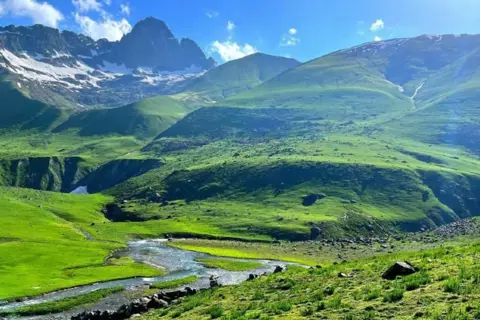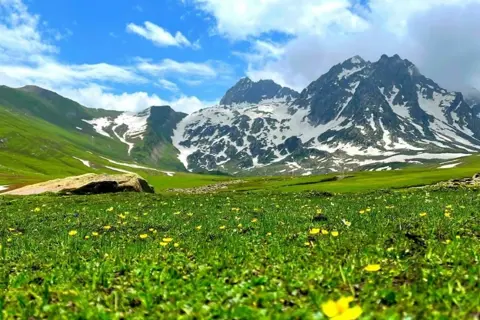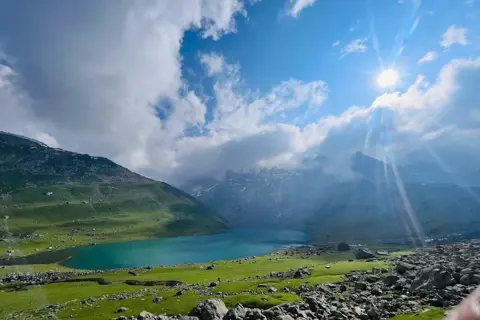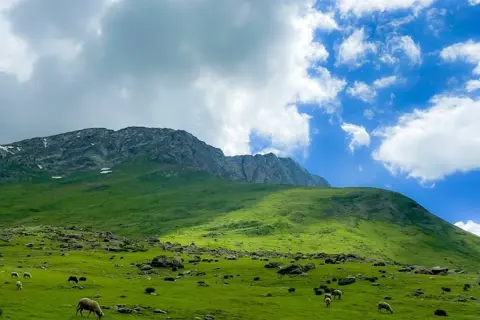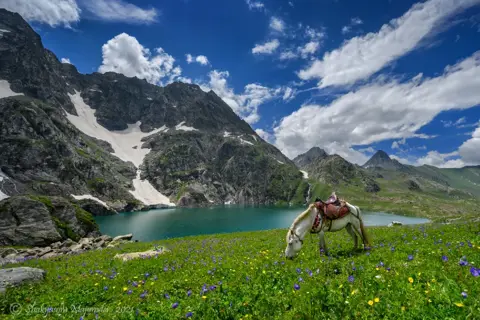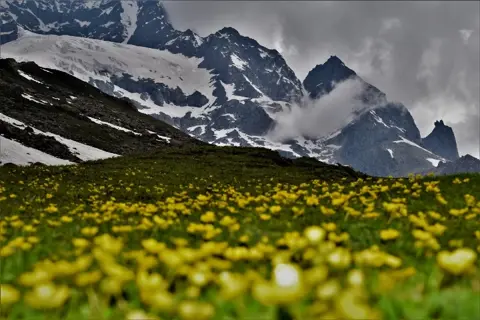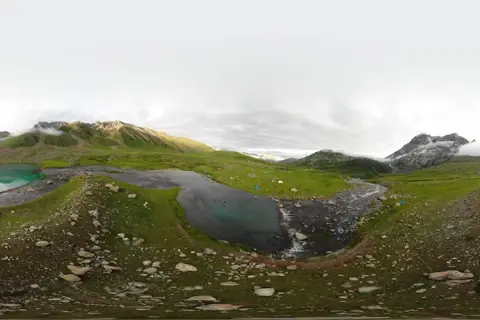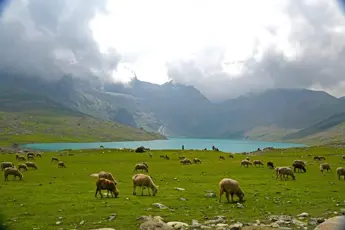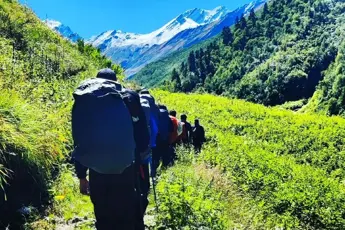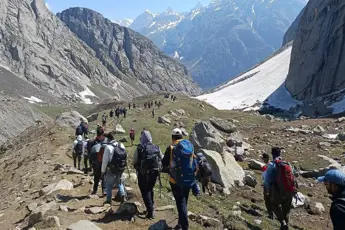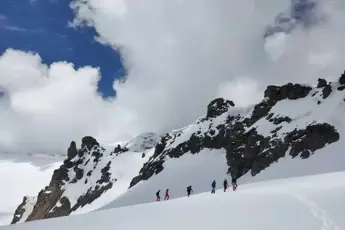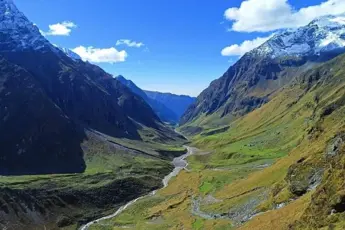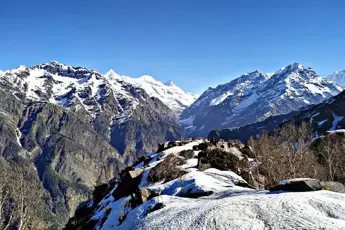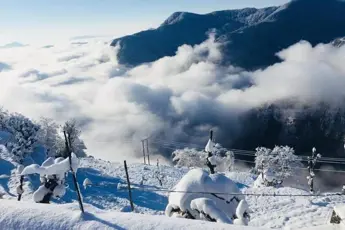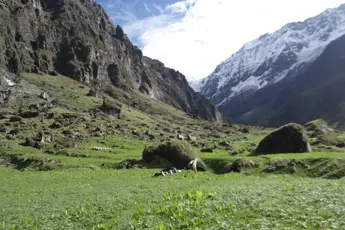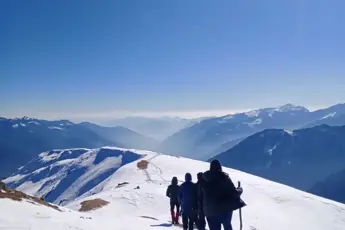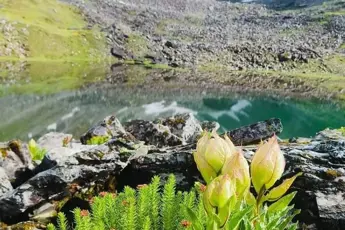The Kashmir Great Lakes Trek is one of the most pretty and moving walks in India, making you feel like you are in a dream as you walk through the new beauty of Kashmir. It covers about 70-75 kilometres, and this week-long walk leads you past seven ice lakes, each one very pretty and set among white peaks, green fields, and bright wild flowers. It starts in Sonamarg and ends in Naranag. The walk shows you nature’s best works Vishansar, Kishansar, Gadsar, Satsar, Gangbal, and Nundkol are some of the cool lakes you see on the way. These lakes show the big Himalayas like glass and change from light blue to dark blue based on the time and weather, making a never-still show of beauty.What makes this walk special is how the land changes from hard mountain paths and thick pine woods to wide green fields and meadows full of flowers. The high spots, like Gadsar Pass (13,800 ft), give wide and magical views. As you walk, you see houses of moving sheep farmers (Gujjars), which makes the walk feel more real and rich. Even though it is seen as quite hard, the Kashmir Great Lakes Trek is worth the work for those who want to deeply feel the Himalayas. It’s best for those who have walked a lot before and are in good shape. This walk is not just a path through hills; it’s a song-like look at Kashmir’s wild and calm beauty. For those who love nature, taking photos, and being alone, the Kashmir Great Lakes Trek is one of the best trips in the Himalayas you can’t forget.History of Kashmir Great Lakes TrekThe Kashmir Great Lakes Trek is now seen as a stunning highland trip, but it comes from a place with deep roots in history, myths, and old ways. Long ago, the area around the trek was key for its perfect spot, rich natural gifts, and deep beliefs. Though today we see it as fun, its paths were walked by herdsmen, traders, holy men, and local people for hundreds of years. Kashmir was a mix of big powers, new ideas, and different faiths. Old writings from Hinduism and Buddhism show us it as a holy place, named the “Abode of Shiva” or “Sharada Peeth.” Lakes like Gangbal, a big one on the trek, are very important in old stories. Gangbal Lake, at the foot of Mount Harmukh, is said to be the first source of the sacred river Ganga. Tales say that the last rites done here are as good as done in the Ganges in Haridwar or Varanasi. Kashmiri Hindus (Pandits) have made trips here for ages during the Harmukh-Gangbal Yatra, which still happens every year. Long ago, the paths along the Kashmir Great Lakes were also walked by shepherds like the Gujjars and Bakarwals, moving groups who still come and go with their animals. These groups used the land’s wide fields, high passes, and lakes to feed sheep and goats a long time ago, keeping a simple life that stays much the same today. In the times of the Mughal big chiefs, like Jahangir and Akbar, they travelled through Kashmir to stay cool away from the low, hot lands. Jahangir loved the look of Kashmir, and he walked the highlands. There are no tales of these big chiefs at these lakes, but the valleys and fields of Kashmir were used a lot for royal hunts and rest times. The British also loved the high beauty of Kashmir. They stayed mostly in Srinagar and Gulmarg, but their first map makers and nature thinkers wrote about many high lakes. Nearby Places of Kashmir Great LakesSonamarg: Sonamarg, or "Meadow of Gold," is where you start the Kashmir Great Lakes Trek. High up at 2,800 meters, it's known for wide green fields, snow-capped tops, and the Sindh River running by. It’s a loved spot for both having fun and walking - it has fishing, camping, and horse trips to the nearby Thajiwas glacier.Naranag: Naranag, where the trek ends, is a lesser-known treasure of Kashmir. It's famous for the old temple ruins set up by the king Lalitaditya in the 800s, made for Lord Shiva. The place, with pine woods around and clear mountain views, is also a start for other high walks and is full of both spirit and long tales.Gulmarg: About 3 hours from Sonamarg, you find Gulmarg, one of India’s top ski spots. Known for winter fun, wide fields, and housing the world's second-highest cable car, it draws those who seek thrills all year. It's the best spot to stop by before or after your trek to relax or seek winter fun.Srinagar: Only a few hours' drive from both Sonamarg and Naranag, Srinagar is Kashmir's life centre. Known for Dal Lake, boat rides, big old gardens, and busy local markets, it's the top place to get to know Kashmiri life and traditions. It's also a main spot for getting around, making it the key to most treks in the area.Thajiwas Glacier: Close to Sonamarg, Thajiwas Glacier is where you can go for a short walk or horse ride. It shows a big view of snow-covered peaks, ice rivers, and rich fields, making it a great place to get used to the heights before starting the Kashmir Great Lakes Trek.Baltal: Near Sonamarg, Baltal is the spot from where people start the annual Amarnath Yatra. With hard land and snow-topped mountains around, it's a key holy place and a beautiful valley that shows off the wild nature of Kashmir. A visit here is good for its quiet and deep meaning.Best Time to Visit Kashmir Great Lakes TrekJuly to September – Peak Trekking Season: The best time to go for the Kashmir Great Lakes Trek is from July to early September. In this span, the snow is mostly gone, so paths are clear, and the highland fields are bright with flowers. The sky is often clear, and it is warm, great for both walking and taking pictures. Lakes like Vishansar, Gadsar, and Gangbal show off deep blue and green colours. Wildflowers spread far and make the view bright, and you can see far around to the big hills.Mid-June – Early Accessibility (for Experienced Trekkers): From mid to late June, paths start to be passable, but there might still be snow, mostly when you go high, like at Gadsar Pass. This is a good pick for those who love snow hikes and don't mind fewer people. But crossing waters can be tough due to melting snow, and the weather can change fast, maybe even with some snow or rain.Mid-September – Beginning of Autumn: Come mid-September, it's the end of the trek time. The flowers start to go away, but nature turns rich with shades of orange and yellow as fall comes. There are fewer people, making it quieter. Yet, it does get colder at night, and snow might come back up high, so be ready for the cold.Off-Season – October to June (Not Recommended): From October to early June, this place is not easy to reach because of a lot of snow and very cold air. Paths are hidden under snow, and the weather isn’t fit for hiking. In these months, it's best to stay clear for your safety unless you're with experts on a snow trip.How to Reach Kashmir Great Lakes TrekBy Airport: The nearest airport for this trek is Sheikh ul-Alam International Airport (Srinagar Airport), which links to big cities like Delhi, Mumbai, Bangalore, and Chandigarh. From the airport, you can grab a cab or share a ride to Sonamarg, where the trek starts, about 80 km away (takes around 2.5 to 3 hours). Srinagar also has places to stay, rent gear, and get local tips before your trek starts.By Road: Srinagar is the key spot for roads to Sonamarg. The drive from Srinagar to Sonamarg has great views and good roads. Buses and shared rides can be caught from Srinagar's TRC (Tourist Reception Centre), or you can book a private ride. If coming from places like Jammu, follow NH44 to Srinagar, then head to Sonamarg.By Railway Station: Jammu Tawi, about 300 km from Srinagar, is the nearest big train station. It has trains from places like Delhi, Kolkata, and Mumbai. From Jammu, head to Srinagar by bus, shared ride, or private car. The road trip is about 8 to 10 hours, moving through the scenic Pir Panjal range. Or, take a flight from Jammu to Srinagar.Why Book with escape2exploreWhen exploring the Kashmir Great Lakes Trek and beyond, escape2explore stands out as a trusted name in adventure and experiential travel. Here’s why hundreds of travellers choose us for their getaways:Trusted, Well-Reviewed Local Operator: escape2explore has gained the trust of thousands of content tourists all over India. With persistent positive feedback and an unblemished reputation for delivering quality experiences, we assure you that your experience will be hassle-free, memorable, and value-packed. Our insider local knowledge guarantees that you will always be in safe hands.Seasoned Guides: Our trips are led by friendly, trained, and professional guides who are passionate about the outdoors and your safety. Whether it's a beach trek, a cultural tour, or a spiritual walk through temples, our team knows the terrain, the stories, and how to make each moment count.Safe & Curated Itineraries: Your safety is our number one priority. Our tour packages are thoughtfully crafted with safety measures, researched accommodations, and easy travel arrangements. We take care of the details so you can have the experience hassle-free and worry-free.Unique Experience That You Won't Find Anywhere Else: With escape2explore, you discover more than the tourist attractions. We go off the beaten track with hidden beaches, unusual treks, offbeat cultural destinations, and true interactions.







